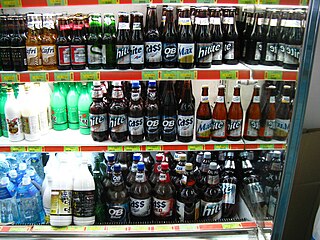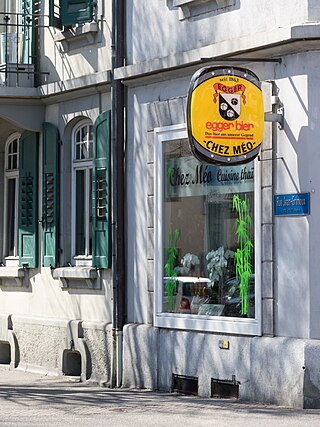
Low-alcohol beer is beer with little or no alcohol by volume that aims to reproduce the taste of beer while eliminating or reducing the inebriating effect, carbohydrates, and calories of regular alcoholic brews. Low-alcohol beers can come in different beer styles such as lagers, stouts, and ales. Low-alcohol beer is also known as light beer, non-alcoholic beer, small beer, small ale, or near-beer.

There is a long history of alcoholic drinks in China. They include rice and grape wine, beer, whisky and various liquors including baijiu, the most-consumed distilled spirit in the world.

Tsingtao Brewery Co. Ltd. is China's second largest brewery, with about 15% of domestic market share and also accounts for half of China's national beer exports.

Carlsberg A/S is a Danish multinational brewer. Founded in 1847 by J. C. Jacobsen, the company's headquarters is in Copenhagen, Denmark. Since Jacobsen's death in 1887, the majority owner of the company has been the Carlsberg Foundation. The company's flagship brand is Carlsberg. Other brands include Tuborg, Kronenbourg, Somersby cider, Holsten, Neptun, Belgian Grimbergen, Fix, one of Greece's oldest brands and more than 500 local beers. The company employs around 41,000 people, primarily in Europe and Asia. Carlsberg is currently the 6th largest brewery in the world based on revenue.
Beer in India has been prepared from rice or millet for thousands of years. In the 18th century, the British introduced European beer to India. Beer is not as popular as stronger alcoholic beverages like desi daru and Indian-made foreign liquor, such as Indian whiskey. The most popular beers in India are strong beers.

In the United States, beer are manufactured in breweries which range in size from industry giants to brew pubs and microbreweries. The United States produced 196 million barrels (23.0 GL) of beer in 2012, and consumes roughly 28 US gallons (110 L) of beer per capita annually. In 2011, the United States was ranked fifteenth in the world in per capita consumption, while total consumption was second only to China.

The Asahi Group Holdings, Ltd. is a Japanese beverage holding company headquartered in Sumida, Tokyo.
Harbin Brewery is a Chinese brewery founded in 1900 in Harbin, China. As China's fourth largest brewery and its oldest one, it has a leading position in Northeast China and owns the Hapi beer brand.

Beer in Japan mostly comes from the country's four major breweries, Asahi, Kirin, Sapporo and Suntory, which mainly produce pale lagers around 5% ABV. Beer is immensely popular, far ahead of sake consumption.

Beer, called maekju in Korean, was first introduced to Korea in the early 20th century. Seoul's first brewery opened in 1908. Two current major breweries date back to the 1930s. The third brewery established in Korea, Jinro Coors Brewery, was founded in the 1990s. It was later acquired by Oriental Breweries (OB). Hite Breweries's former name was Chosun Breweries, which was established in 1933. The company changed its name to Hite Breweries in 1998. OB Breweries established as Showa Kirin Breweries in 1933. The company changed its name to OB Breweries in 1995.

Beer in Asia began when beer was produced in Sumer, Mesopotamia circa 6000 years ago. It was introduced by Europeans in the 19th century, with modern breweries established in British India, the Dutch East Indies, China, and Japan. Asia's first modern brewery was established in 1830 in India entirely using European brewing technology.
Heineken N.V. is a Dutch brewer which owns a worldwide portfolio of over 170 beer brands, mainly pale lager, though some other beer styles are produced. The two largest brands are Heineken and Tecate; though the portfolio includes Amstel, Fosters, Sagres, Cruzcampo, Skopsko, Affligem, Żywiec, Starobrno, Zagorka, Zlatý Bažant, Laško and Birra Moretti.
The Qingdao International Beer Festival is a yearly festival held in Qingdao in Shandong province, China. The event is jointly sponsored by national state ministries and the Qingdao Municipal Government.

Beer in the Philippines is mainly produced by two large breweries, San Miguel Corporation, which produces San Miguel Pale Pilsen, and Asia Brewery, the country's second-largest brewery. In addition, there are a number of microbreweries across the nation.

Beer in Taiwan was dominated by monopoly products until 2002, when free trade became law in Taiwan. The main domestic brand remains Taiwan Beer, brewed by the publicly owned Taiwan Tobacco and Liquor Corporation that succeeded the government's monopoly bureau in 2002.
The history of beer in Hong Kong dates back to the mid-19th century. Currently the best selling beer is San Miguel, brewed by San Miguel Brewery Hong Kong. San Miguel had been brewed in Sham Tseng since 1948 and later moved to Yuen Long until 2007. The brewery was reopened in 2009.

Beer and alcohol is an integral part of Tanzanian society and local brands hold a strong sense of national pride among the Tanzanian population. There is a considerable amount of brewing and drinking done in the country. Tanzania ranks 6th in Africa for beer consumption and contributes to over 3% of the African consumption. However, over 90% of the national consumption is either homemade or from the informal sector. Bottled beer is expensive for the majority of the population and is almost 6 times more expensive than the maize beers. Nonetheless, beer sales and taxes are a vital part of the Tanzanian economy.

Alcohol in Malaysia refers to the consumption, industry and laws of alcohol in the Southeast Asian country of Malaysia. Although Malaysia is a Muslim majority country, the country permits the selling of alcohol to non-Muslims. There are no nationwide alcohol bans being enforced in the country, with the exception of Kelantan and Terengganu which is only for Muslims. The Islamic party respects the rights of non-Muslims with non-Muslim establishments like Chinese restaurants and grocery shops being excluded from such bans. The federal territory of Kuala Lumpur has the highest alcohol consumption in the country, followed by the states of Sarawak in second place and Sabah in third place.

Beer in Malaysia started in 1968, when two leading breweries of Guinness and Malayan Breweries merged to form a new company known as Guinness Anchor Berhad. Previously, the distribution of beer in Malaysia is mainly distributed by Malayan Breweries Limited which is centred in neighbouring Singapore. Carlsberg establish its first brewery outside Kuala Lumpur in 1970. By 2007, one local brewery began to establish their presence in the country although the demands for commercial beers are much higher than a new local brand. Most beers in the Malaysian markets are imported from neighbouring countries such as Singapore, Thailand, Indonesia, Philippines and Vietnam. In 2022, finally Malaysia had its very own craft beer brand known as PaperKite. PaperKite is also the first Malaysian craft beer brand to win the World Beer Awards in 2023.

Switzerland has a long tradition of brewing, with significant domestic beer production and a growing craft brewing sector.















